Sony XR-4890, XR-4880, XR-5880R, XR-5890R User Manual
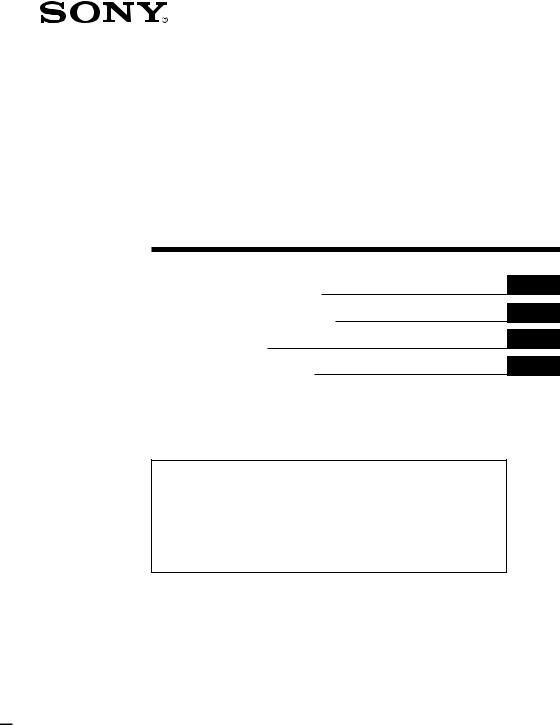
3-865-670-11 (1)
FM/MW/LW
Cassette
Car Stereo
Operating Instructions
Manual de instrucciones
Bruksanvisning
Manual de instruções
GB
ES
SE
PT
For installation and connections, see the supplied installation/connections manual.
Para obtener información sobre la instalación y las conexiones, consulte el manual de instalación/conexiones suministrado.
Vi hänvisar till det medföljande häftet angående montering/anslutningar.
Para a instalação e as ligações, consulte o manual de instalação/ligações fornecido.
XR-5890R
XR-5880R
XR-4890
XR-4880
1999 by Sony Corporation

Welcome !
Thank you for purchasing this Sony Cassette Player. This unit lets you enjoy a variety of features as well as an optional rotary commander.
Table of Contents |
|
Location of controls ............................................ |
3 |
Getting Started |
|
Resetting the unit ................................................ |
4 |
Detaching the front panel .................................. |
4 |
Setting the clock .................................................. |
5 |
Cassette Player |
|
Listening to a tape ............................................... |
6 |
Playing a tape in various modes ....................... |
7 |
Radio |
|
Memorizing stations automatically |
|
— Best Tuning Memory (BTM) .................... |
7 |
Memorizing only the desired stations ............. |
8 |
Receiving the memorized stations ................... |
8 |
RDS (XR-5890R/5880R only) |
|
Overview of the RDS function .......................... |
9 |
Displaying the station name .............................. |
9 |
Retuning the same programme automatically |
|
— Alternative Frequencies (AF) ................ |
10 |
Listening to traffic announcements ................ |
12 |
Presetting the RDS stations with the AF |
|
and TA data ................................................... |
12 |
Locating a station by programme type .......... |
13 |
Setting the clock automatically ....................... |
14 |
Other Functions |
|
Labelling the rotary commander .................... |
15 |
Using the rotary commander .......................... |
15 |
Adjusting the sound characteristics ............... |
17 |
Attenuating the sound ..................................... |
17 |
Changing the sound and display settings ..... |
17 |
Boosting the bass sound |
|
— D-bass ....................................................... |
18 |
Additional Information |
|
Precautions ......................................................... |
18 |
Maintenance ....................................................... |
19 |
Dismounting the unit ....................................... |
20 |
Specifications ..................................................... |
21 |
Troubleshooting guide ..................................... |
22 |
2
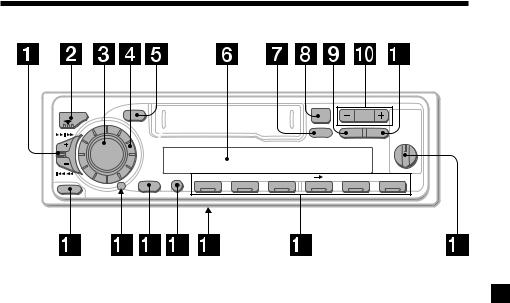
Location of controls
|
|
|
|
|
|
– |
+ |
MODE |
SOUND |
|
|
|
6 |
PRST |
|
|
|
|
|
|
|
|
D-BASS |
SEEK / AMS |
|
|
|
|
DSPL |
PTY |
AF/TA |
|
|
|
|
|
|||
|
|
|
|
|
|
|
OFF 1 2 |
|
SOURCE |
|
|
|
|
|
3 |
|
|
|
|
|
|
|
|
|
SHIFT |
|
SET UP |
PLAY MODE |
|
|
|
RELEASE |
OFF |
1 |
2 |
3 |
4 |
5 |
6 |
|
|
|
|
|
|
|
|
XR-5890R/5880R
Refer to the pages listed for details.
1SEEK/AMS (seek/Automatic Music Sensor/manual search) control
6, 8, 11, 14
2MODE (*) button
During tape playback: Playback direction change 6
During radio reception:
BAND select 7, 8
3SOURCE (TAPE/TUNER) button 6, 7, 8, 12
4Dial (volume/bass/treble/left-right/rear- front control) 5, 17
5 SOUND button 17
6 Display window
7DSPL (display mode change) button 6, 9, 10
8 6 (eject) button 6
9PTY button*
RDS Programme 14
!º PRST button
During radio reception:
Preset stations select 8
!¡ AF/TA button* 10, 11, 12, 13
!™ RELEASE (front panel release) button
4, 20
!£ Reset button (located on the front side of the unit behind the front panel) 4
!¢ OFF button 4, 6
!∞ SHIFT button
PLAY MODE 7, 8, 11, 13 SET UP 5, 14, 17
!§ POWER SELECT switch
(located on the bottom of the unit)
See “POWER SELECT switch” in the Installation/Connections manual.
!¶ Number buttons 8, 11, 13
!• D-BASS control 18
* XR-5890R/5880R only
3
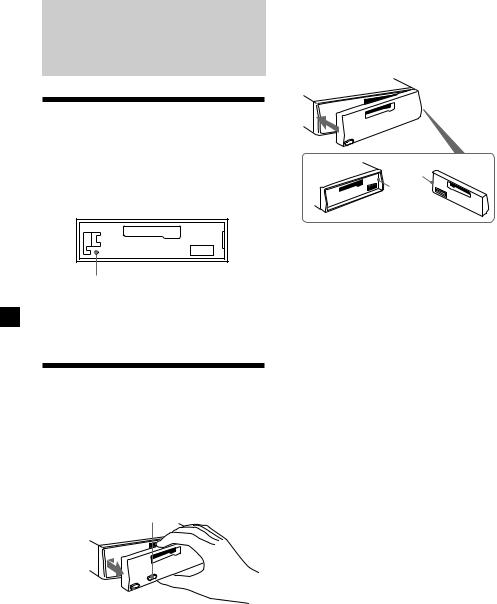
Getting Started
Resetting the unit
Before operating the unit for the first time or after replacing the car battery, you must reset the unit.
Remove the front panel and press the reset button with a pointed object, such as a ballpoint pen.
Reset button
Note
Pressing the reset button will erase the clock setting and some memorized functions.
Detaching the front panel
You can detach the front panel of this unit to protect the unit from being stolen.
1 Press (OFF).
2Press (RELEASE), then slide the front panel a little to the left, and pull it off towards you.
(OFF)
(RELEASE)

Notes
•Be sure not to drop the panel when detaching it from the unit.
•If you detach the panel while the unit is still turned on, the power will turn off automatically to prevent the speakers from being damaged.
•When carrying the front panel with you, use the supplied front panel case.
Attaching the front panel
Attach part a of the front panel to part b of the unit as illustrated and push the left side into position until it clicks.
a
b
Notes
•Be sure not to attach the front panel upside down.
•Do not press the front panel too hard against the unit when attaching it.
•Do not press too hard or put excessive pressure on the display window of the front panel.
•Do not expose the front panel to direct sunlight or heat sources such as hot air ducts, and do not leave it in a humid place. Never leave it on the dashboard of a car parked in direct sunlight or where there may be a considerable rise in temperature.
Caution alarm
If you turn the ignition key switch to the OFF position without removing the front panel, the caution alarm will beep for a few seconds (only when the POWER SELECT switch on the bottom of the unit is set to the A position).
4
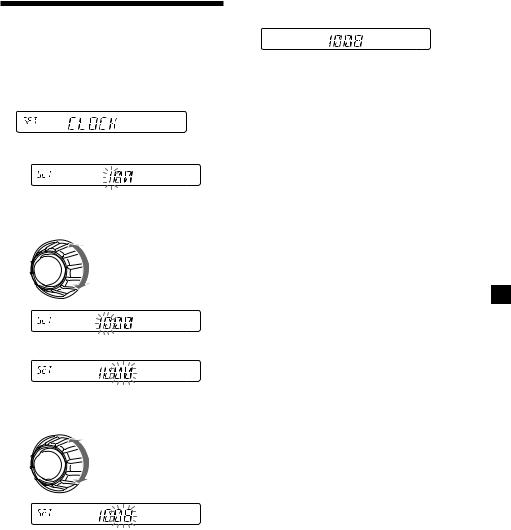
Setting the clock
The clock uses a 24-hour digital indication.
Example: To set the clock to 10:08
1Press (SHIFT), then press (2) (SET UP) repeatedly until “CLOCK” appears.
1 Press (4) (n).
The hour indication flashes.
2 Set the hour.
to go backward
to go forward
3 Press (4) (n).
The minute indication flashes.
4 Set the minute.
to go backward
to go forward
2 Press (SHIFT).
The clock starts.
3Press (SHIFT).
After the clock setting is complete, the display returns to normal playback mode.
Note
If the POWER SELECT switch on the bottom of the unit is set to the B position, turn the power on first, then set the clock.
5
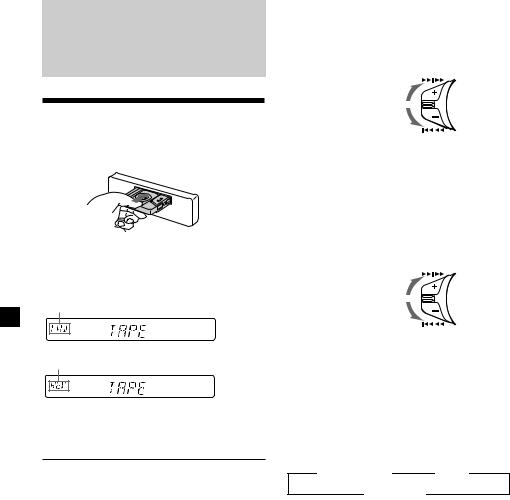
Cassette Player
Listening to a tape
Insert a cassette.
Playback starts automatically.
If a cassette is already inserted, press (SOURCE) repeatedly until “FWD” or “REV” appears to start playback.
The side facing up is played.
The side facing down is played.
Tip
To change the tape‘s playback direction, press
(MODE) (*).
To |
Press |
Stop playback |
(OFF) |
Eject the cassette |
6 |
|
|
Fast-winding the tape
During playback, push the SEEK/AMS control up or down and hold.
SEEK / AMS
Fast-forward
Rewind
To start playback during fast-forwarding or rewinding, press (MODE) (*).
Locating a specific track
—Automatic Music Sensor (AMS)
During playback, push the SEEK/AMS control up or down and release for each track you want to skip.
You can skip up to nine tracks at one time.
SEEK / AMS
To locate succeeding tracks
To locate preceding tracks
Note
The AMS function may not work when:
—the blanks between tracks are shorter than four seconds
—there is noise between tracks
—there are long sections of low volume or quiet sections.
Changing the display item
Each time you press (DSPL), the item changes as follows:
z Tape playback |
z Clock |
Frequency*Z
*While either of the following functions are activated.
—ATA function
—AF/TA function (XR-5890R/5880R)
After you select the desired item, the display will automatically change to the Motion Display mode after a few seconds.
In the Motion Display mode, all the above items are scrolled in the display one by one in order.
Tip
The Motion Display mode can be turned off. (See “Changing the sound and display settings” on page 17).
6

Playing a tape in various modes
You can play the tape in various modes: •REP (Repeat Play) repeats the current track. •METAL (Metal)* lets you play a metal or
CrO2 tape.
•BL SKP (Blank Skip) skips blanks longer than eight seconds.
•ATA (Automatic Tuner Activation) turns on the tuner automatically when fast-winding the tape.
1During playback, press (SHIFT).
“SHIFT-ON” appears in the display.
2Press (3) (PLAY MODE) repeatedly until the desired play mode appears.
Each time you press (3) (PLAY MODE), the item changes as follows:
REP nMETAL*nBL SKP nATA
*XR-5890R/4890 only
3 Press (4) (n) to select “ON.”
Play mode starts.
4 Press (SHIFT).
To return to normal playback mode, select “OFF” in step 3 above.
Note
If the “SFT” indication appears, press (SHIFT) to complete the mode setting.
Radio
Memorizing stations automatically
— Best Tuning Memory (BTM)
The unit selects the stations with the strongest signals and memorizes them in the order of their frequencies. You can store up to 6 stations on each band (FM1, FM2, FM3, MW, and LW).
Caution
When tuning in stations while driving, use Best Tuning Memory to prevent accidents.
1Press (SOURCE) repeatedly to select the tuner.
Each time you press (SOURCE), the source changes as follows:
TUNER ˜TAPE
2Press (MODE) repeatedly to select the band.
Each time you press (MODE), the band changes as follows:
z FM1 z FM2 z FM3 z MW z LW 
3Press (SHIFT), then press (3) (PLAY
MODE) repeatedly until “B.T.M” appears.
4Press (4) (n).
The unit stores stations in the order of their frequencies on the number buttons.
A beep sounds when the setting is stored.
5 Press (SHIFT).
Notes
•The unit does not store stations with weak signals. If only a few stations can be received, some number buttons will retain their former setting.
•When a number is indicated in the display, the unit starts storing stations from the one currently displayed.
7

Memorizing only the desired stations
You can preset up to 18 FM stations (6 each for FM1, 2, and 3), up to 6 MW stations, and up to 6 LW stations in the order of your choice.
1Press (SOURCE) repeatedly to select the tuner.
2Press (MODE) repeatedly to select the band.
3Push the SEEK/AMS control up or down to tune in the station that you want to store on the number button.
4Press and hold the desired number button ((1) to (6)) until “MEM” appears.
The number button indication appears in the display.
Note
If you try to store another station on the same number button, the previously stored station will be erased.
Receiving the memorized stations
1Press (SOURCE) repeatedly to select the tuner.
2Press (MODE) repeatedly to select the band.
3Press the number button ((1) to (6)) on which the desired station is stored.
Tip
Press either side of (PRST) to receive the stations in the order they are stored in the memory (Preset Search Function).
If you cannot tune in a preset station
Push and release the SEEK/AMS control up or down to search for the station (automatic tuning).
Scanning stops when the unit receives a station. Push the SEEK/AMS control up or down repeatedly until the desired station is received.
Note
If the automatic tuning stops too frequently, press (SHIFT), then press (3) (PLAY MODE) repeatedly until “LOCAL” (local seek mode) is displayed. Then press (4) (n) to select “LOCAL-ON.” Press (SHIFT). Only the stations with relatively strong signals will be tuned in.
Tip
If you know the frequency of the station you want to listen to, push the SEEK/AMS control up or down and hold until the desired frequency appears (manual tuning).
If FM stereo reception is poor
— Monaural Mode
1During radio reception, press (SHIFT), then press (3) (PLAY MODE) repeatedly until “MONO” appears.
2Press (4) (n) repeatedly until “MONO-
ON“ appears.
The sound improves, but becomes monaural (“ST” disappears).
3 Press (SHIFT).
To return to normal mode, select “MONOOFF” in step 2 above.
8

Changing the display item
Each time you press (DSPL), the item changes as follows:
Frequency (Station Name)* ˜Clock
*When you tune in an FM station that transmits RDS data, the station name appears (XR-5890R/ 5880R only).
After you select the desired item, the display will automatically change to the Motion Display mode after a few seconds.
In the Motion Display mode, all the above items are scrolled in the display one by one in order.
Tip
The Motion Display mode can be turned off. (See “Changing the sound and display settings” on page 17).
RDS (XR-5890R/5880R only)
Overview of the RDS function
Radio Data System (RDS) is a broadcasting service that allows FM stations to send additional digital information along with the regular radio programme signal. Your car stereo offers you a variety of services. Here are just a few: retuning the same programme automatically, listening to traffic announcements, and locating a station by programme type.
Notes
•Depending on the country or region, not all of the RDS functions are available.
•RDS may not work properly if the signal strength is weak or if the station you are tuned to is not transmitting RDS data.
Displaying the station name
The name of the current station lights up in the display.
Select an FM station (page 7).
When you tune in an FM station that transmits RDS data, the station name appears in the display.
Note
The “*” indication means that an RDS station is being received.
9
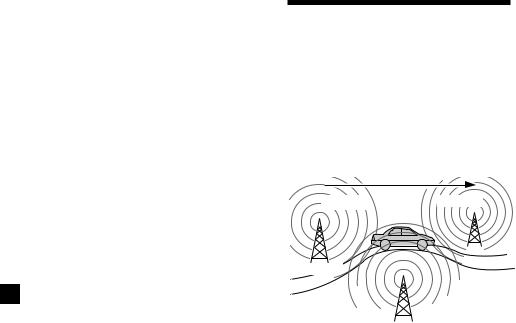
Changing the display item
Each time you press (DSPL), the item changes as follows:
Station Name (Frequency) ˜Clock
After you select the desired item, the display will automatically change to the Motion Display mode after a few seconds.
In the Motion Display mode, all the above items are scrolled in the display one by one in order.
Tip
The Motion Display mode can be turned off. (See “Changing the sound and display settings” on page 17).
Note
“NO NAME” appears if the received station does not transmit RDS data (XR-5890R/5880R only).
Retuning the same programme automatically
— Alternative Frequencies (AF)
The Alternative Frequencies (AF) function automatically selects and retunes the station with the strongest signal in a network. By using this function, you can continuously listen to the same programme during a longdistance drive without having to retune the station manually.
Frequencies change automatically.
98.5MHz |
96.0MHz |
Station |
102.5MHz
1 Select an FM station (page 7).
2Press (AF/TA) repeatedly until “AF-ON” appears.
The unit starts searching for an alternative station with a stronger signal in the same network.
Note
When there is no alternative station in the area and you do not need to search for an alternative station, turn the AF function off by pressing (AF/TA) repeatedly until “AF TA-OFF” appears.
10

Changing the display item
Each time you press (AF/TA), the item changes as follows:
” TA-ON |
|
” AF TA-ON* |
|
|
|
|
AF-ON “ |
AF TA-OFF “ |
|
||
|
|
||||
*Select this to turn on both the AF and TA functions.
Notes
•When “NO AF” and the station name flash alternately, it means that the unit cannot find an alternative station in the network.
•If the station name starts flashing after selecting a station with the AF function on, this indicates that no alternative frequency is available. Push the SEEK/AMS control up or down while the station name is flashing (within eight seconds). The unit starts searching for another frequency with the same PI (Programme Identification) data (“PI SEEK” appears and no sound is heard). If the unit cannot find another frequency, “NO PI” appears, and the unit returns to the previously selected frequency.
Listening to a regional programme
The “REG-ON” (regional on) function lets you stay tuned to a regional programme without being switched to another regional station. (Note that you must turn the AF function on.) The unit is factory preset to “REG-ON,” but if you want to turn off the function, do the following.
1During radio reception, press (SHIFT), then press (3) (PLAY MODE) repeatedly until “REG” appears.
2Press (4) (n) repeatedly until “REG-OFF” appears.
3Press (SHIFT).
Note that selecting “REG-OFF” might cause the unit to switch to another regional station within the same network.
To return to regional on, select “REG-ON” in step 2 above.
Note
This function does not work in the United Kingdom and in some other areas.
Local link function (United Kingdom only)
The Local Link function lets you select other local stations in the area, even if they are not stored on your number buttons.
1Press a number button that has a local station stored on it.
2Within five seconds, press the number button of the local station again.
3Repeat this procedure until the desired local station is received.
11

Listening to traffic announcements
The Traffic Announcement (TA) and Traffic Programme (TP) data let you automatically tune in an FM station that is broadcasting traffic announcements even if you are listening to other programme sources.
Press (AF/TA) repeatedly until “TA-ON” or “AF TA-ON” appears.
The unit starts searching for traffic information stations. “TP” appears in the display when the unit finds a station broadcasting traffic announcements. When the traffic announcement starts, “TA” flashes. The flashing stops when the traffic announcement is over.
Tip
If the traffic announcement starts while you are listening to another programme source, the unit automatically switches to the announcement and goes back to the original source when the announcement is over.
Notes
•“NO TP” flashes for five seconds if the received station does not broadcast traffic announcements. Then, the unit starts searching for a station that broadcasts it.
•When “EON” appears with “TP” in the display, the current station makes use of broadcast traffic announcements by other stations in the same network.
To cancel the current traffic announcement
Press (AF/TA) or (SOURCE).
To cancel all traffic announcements, turn off the function by pressing (AF/TA) until “AF TA-OFF” appears.
Presetting the volume of traffic announcements
You can preset the volume level of the traffic announcements beforehand so you won’t miss the announcement. When a traffic announcement starts, the volume will be automatically adjusted to the preset level.
1 Select the desired volume level.
2Press (AF/TA) for two seconds.
”TA“ appears and the setting is stored.
Receiving emergency announcements
If an emergency announcement comes in while you are listening to the radio, the programme will automatically switch to it. If you are listening to a source other than the radio, the emergency announcements will be heard if you set AF or TA to on. The unit will then automatically switch to these announcements no matter which source you are listening to at the time.
Presetting the RDS stations with the AF and TA data
When you preset RDS stations, the unit stores each station’s data as well as its frequency, so you don’t have to turn on the AF or TA function every time you tune in the preset station. You can select a different setting (AF, TA, or both) for individual preset stations, or the same setting for all preset stations.
12

Presetting the same setting for all preset stations
1 Select an FM band (page 7).
2Press (AF/TA) repeatedly to select either
“AF-ON,” “TA-ON” or “AF TA-ON” (for both AF and TA functions).
Note that selecting “AF TA-OFF” stores not only RDS stations, but also non-RDS stations.
3Press (SHIFT), then press (3) (PLAY
MODE) repeatedly until “B.T.M” appears.
4 Press (4) (n) until “B.T.M” flashes.
5 Press (SHIFT).
Presetting different settings for each preset station
1Select an FM band, and tune in the desired station.
2Press (AF/TA) repeatedly to select either
“AF-ON,” “TA-ON” or “AF TA-ON” (for both AF and TA functions).
3Press the desired number button and hold until “MEM” appears.
Repeat from step 1 to preset other stations.
Tip
If you want to change the preset AF and/or TA setting after you tune in the preset station, you can do so by turning the AF or TA function on or off.
Locating a station by programme type
You can locate the station you want by selecting one of the programme types shown below.
Programme types |
Display |
|
|
News |
NEWS |
|
|
Current Affairs |
AFFAIRS |
|
|
Information |
INFO |
|
|
Sports |
SPORT |
|
|
Education |
EDUCATE |
|
|
Drama |
DRAMA |
|
|
Culture |
CULTURE |
|
|
Science |
SCIENCE |
|
|
Varied |
VARIED |
|
|
Popular Music |
POP M |
|
|
Rock Music |
ROCK M |
|
|
|
|||
Easy Listening |
EASY M |
|
|
|
|||
Light Classical |
LIGHT M |
|
|
Classical |
CLASSICS |
|
|
Other Music Type |
OTHER M |
|
|
Weather |
WEATHER |
|
|
Finance |
FINANCE |
|
|
Children’s Programmes |
CHILDREN |
|
|
Social Affairs |
SOCIAL A |
|
|
Religion |
RELIGION |
|
|
Phone In |
PHONE IN |
|
|
Travel |
TRAVEL |
|
|
Leisure |
LEISURE |
|
|
Jazz Music |
JAZZ |
|
|
Country Music |
COUNTRY |
|
|
National Music |
NATION M |
|
|
Oldies Music |
OLDIES |
|
|
Folk Music |
FOLK M |
|
|
Documentary |
DOCUMENT |
|
|
Not specified |
NONE |
|
|
Note
You cannot use this function in some countries where no PTY (Programme Type selection) data is available.
continue to next page n
13
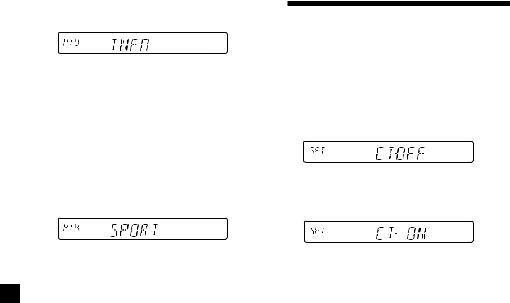
1Press (PTY) during FM reception until
“PTY” appears.
The current programme type name appears if the station is transmitting the PTY data. “- - - - -” appears if the received station is not an RDS station, or if the RDS data has not been received.
2Press (PTY) repeatedly until the desired programme type appears.
The programme types appear in the order shown in the above table. Note that you cannot select “NONE” (Not specified) for searching.
3Push the SEEK/AMS control up or down.
The unit starts searching for a station broadcasting the selected programme type. When the unit finds the programme, the programme type appears again for five seconds.
“NO” and the programme type appear alternately for five seconds if the unit cannot find the programme type. It then returns to the previously selected station.
Setting the clock automatically
The CT (Clock Time) data from the RDS transmission sets the clock automatically.
1During radio reception, press (SHIFT), then press (2) (SET UP) repeatedly until
“CT” appears.
2Press (4) (n) repeatedly until “CT-ON” appears.
The clock is set.
3Press (SHIFT) to return to the normal display.
To cancel the CT function
Select “CT-OFF” in step 2 above.
Notes
•The CT function may not work even though an RDS station is being received.
•There might be a difference between the time set by the CT function and the actual time.
14
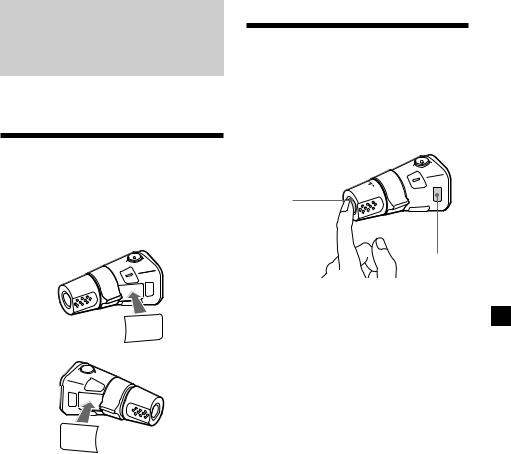
Other Functions
You can also control this unit with an optional rotary commander.
Labelling the rotary commander
Depending on how you mount the rotary commander, attach the appropriate label as shown in the illustration below.
SOUND
MODE
DSPL
DSPL
MODE
SOUND
Using the rotary commander
The rotary commander works by pressing buttons and/or rotating controls.
By pressing buttons
(the SOURCE and MODE buttons)
(SOURCE)
(MODE)
Each time you press (SOURCE), the source changes as follows:
TUNER ˜TAPE
Pressing (MODE) changes the operation in the following ways;
•Tape : playback direction
•Tuner : FM1 nFM2 nFM3 nMW nLW
Tip
When the POWER SELECT switch is set to position B, you can turn on this unit by pressing (SOURCE) on the rotary commander.
15
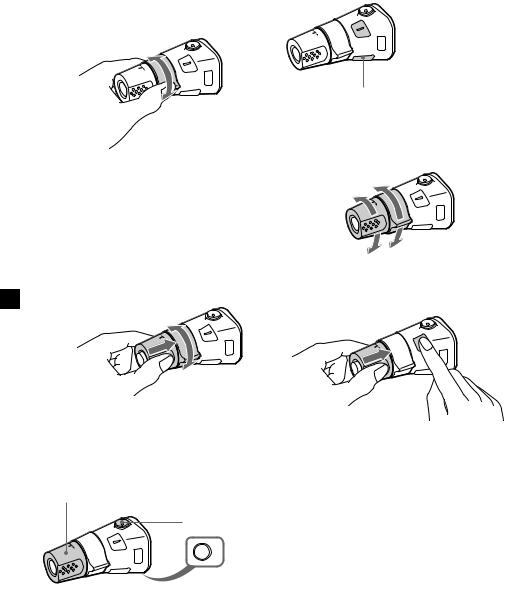
By rotating the control (the SEEK/AMS control)
Rotate the control and release it to:
•Locate the beginnings of tracks on the tape. Rotate and hold the control, and release it to fast-wind the tape. To start playback while fast-winding the tape, press (MODE).
•Tune in stations automatically. Rotate and hold the control to find a specific station.
By pushing in and rotating the control (the PRESET/DISC control)
Push in and rotate the control to:
Receive the stations memorized on the number buttons.
Other operations
Rotate the VOL control to
adjust the volume.
Press (ATT) to attenuate the sound.
OFF
Press (OFF) to turn off the unit.
Press (SOUND) to adjust the volume 
 and sound menu.
and sound menu.
Press (DSPL) to change the displayed items.
Changing the operative direction
The operative direction of controls is factoryset as shown below.
To increase
To decrease
If you need to mount the rotary commander on the right hand side of the steering column, you can reverse the operative direction.
Press (SOUND) for two seconds while pushing the VOL control.
Tip
You can also change the operative direction of these controls with the unit (see “Changing the sound and display settings” on page 17).
16

Adjusting the sound characteristics
You can adjust the bass, treble, balance, and fader.
You can store the bass and treble levels independently for each source.
1Select the item you want to adjust by pressing (SOUND) repeatedly.
VOL (volume) nBAS (bass) n TRE (treble) nBAL (left-right) n FAD (front-rear)
2Adjust the selected item by rotating the dial.
Adjust within three seconds after selecting the item. (After three seconds, the dial function reverts to volume control.)
Attenuating the sound
Press (ATT) on the optional rotary commander.
“ATT-ON” flashes momentarily.
To restore the previous volume level, press (ATT) again.
Tip
The unit decreases the volume automatically when a telephone call comes in (Telephone ATT function) (XR-5890R/4890 only).
Changing the sound and display settings
The following items can be set:
•CLOCK (page 5).
•CT (Clock Time)* (page 14).
•AMBER/GREEN – to change the illumination colour to amber or green.
•BEEP – to turn the beep sound on or off.
•RM (Rotary Commander) – to change the operative direction of the rotary commander.
—Select “NORM” to use the rotary commander as the factory-set position.
—Select “REV” when you mount the rotary commander on the right side of the steering column.
•M.DSPL – to turn the motion display on or off.
1 Press (SHIFT).
2Press (2) (SET UP) repeatedly until the desired item appears.
Each time you press (2) (SET UP), the item changes as follows:
CLOCK nCT* nAMBER/GREEN nBEEP nRM nM.DSPL
*XR-5890R/5880R only.
Note
The displayed item will differ depending on the source.
3Press (4) (n) to select the desired setting (Example: ON or OFF).
4Press (SHIFT).
After the mode setting is complete, the display returns to normal playback mode.
Note
If the “SFT” indication appears, press (SHIFT) to complete the mode setting.
17
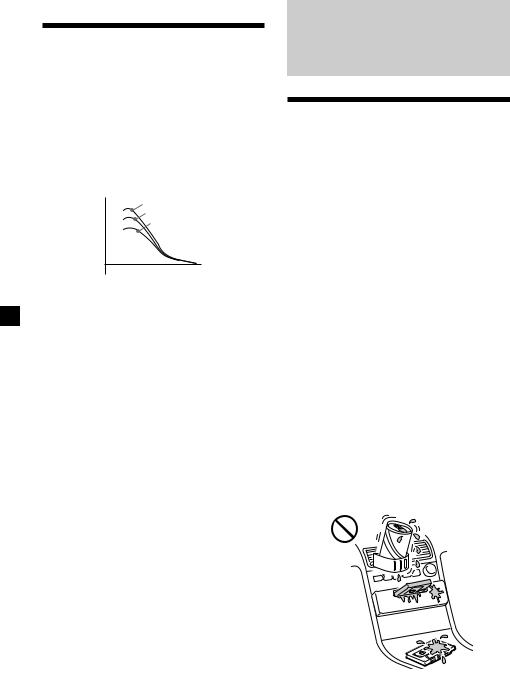
Boosting the bass sound
— D-bass
You can enjoy a clear and powerful bass sound. The D-bass function boosts the low frequency signal with a sharper curve than conventional bass boost.
You can hear the bass line more clearly even while the vocal volume remains the same. You can emphasize and adjust the bass sound easily with the D-BASS control.
Level |
D-BASS 3 |
|
D-BASS 2 |
|
D-BASS 1 |
0dB
Frequency (Hz)
Adjusting the bass curve
Turn the D-BASS control to adjust the bass level (1, 2, or 3).
“D-BASS” appears in the display.
To cancel, turn the control to OFF.
Note
If the bass sound becomes distorted, adjust the D-BASS control or volume.
Additional
Information
Precautions
•If your car was parked in direct sunlight resulting in a considerable rise in temperature inside the car, allow the unit to cool off before operating it.
•If no power is being supplied to the unit, check the connections first. If everything is in order, check the fuse.
•If no sound comes from the speakers of a two-speaker system, set the fader control to the centre position.
•When the tape is played back for a long period, the cassette may become warm because of the built-in power amplifier.
However, this is not a sign of malfunction.
If you have any questions or problems concerning your unit that are not covered in this manual, please consult your nearest Sony dealer.
To maintain high quality sound
If you have drink holders near your audio equipment, be careful not to splash juice or other soft drinks onto the car audio. Sugary residues on this unit or cassette tapes may contaminate the playback heads, reduce the sound quality, or prevent sound reproduction altogether.
Cassette cleaning kits cannot remove sugar from the tape heads.
18
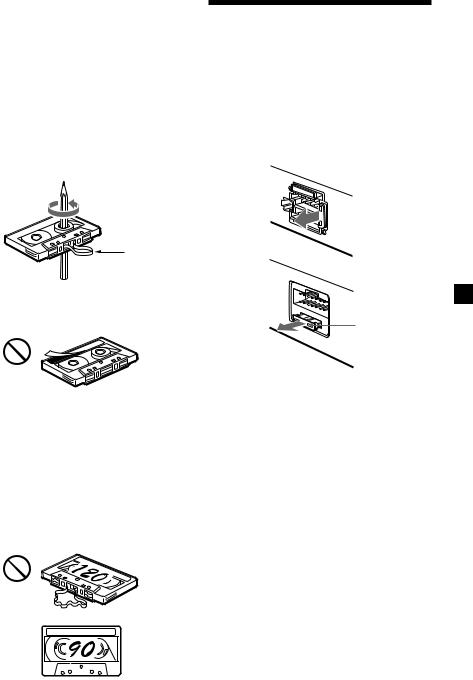
Notes on Cassettes
Cassette care
•Do not touch the tape surface of a cassette, as any dirt or dust will contaminate the heads.
•Keep cassettes away from equipment with built-in magnets such as speakers and amplifiers, as erasure or distortion on the recorded tape could occur.
•Do not expose cassettes to direct sunlight, extremely cold temperatures, or moisture.
•Slack in the tape may cause the tape to be caught in the machine. Before you insert the tape, use a pencil or similar object to turn the reel and take up any slack.
Slack
•Distorted cassettes and loose labels can cause problems when inserting or ejecting tapes. Remove or replace loose labels.
•The sound may become distorted while playing the cassette. The cassette player head should be cleaned after each 50 hours of use.
Cassettes longer than 90 minutes
The use of cassettes longer than 90 minutes is not recommended except for long continuous play. The tape used for these cassettes is very thin and tends to stretch easily. Frequent playing and stopping of these tapes may cause them to become entangled in the cassette deck mechanism.
Maintenance
Fuse replacement
When replacing the fuse, be sure to use one matching the amperage rating stated on the original fuse. If the fuse blows, check the power connection and replace the fuse. If the fuse blows again after replacement, there may be an internal malfunction. In such a case, consult your nearest Sony dealer.
XR-5890R/5880R:

 Fuse (10 A)
Fuse (10 A)
XR-4890/4880:
Fuse (10 A)
Warning
Never use a fuse with an amperage rating exceeding the one supplied with the unit as this could damage the unit.
19
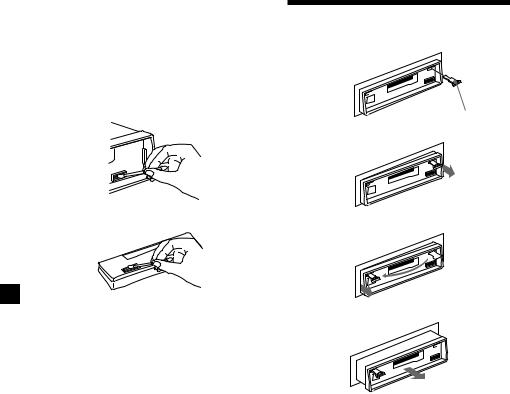
Cleaning the connectors
The unit may not function properly if the connectors between the unit and the front panel are not clean. In order to prevent this, open the front panel by pressing (RELEASE), then detach it and clean the connectors with a cotton swab dipped in alcohol. Do not apply too much force. Otherwise, the connectors may be damaged.
Main unit
Back of the front panel
Notes
•For safety, turn off the engine before cleaning the connectors and remove the key from the ignition switch.
•Never touch the connectors directly with your fingers or any metal device.
Dismounting the unit
1
Release key (supplied)
2
3
4
20

Specifications
Cassette player section
Tape track |
4-track 2-channel stereo |
|
Wow and flutter |
0.08 % (WRMS) |
|
Frequency response |
30 – 18,000 Hz |
|
Signal-to-noise ratio |
|
|
|
Cassette type |
|
|
TYPE II, IV* |
61 dB |
|
TYPE I |
58 dB |
|
* XR-5890R/4890 only |
|
Tuner section
FM
Tuning range |
87.5 – 108.0 MHz |
Aerial terminal |
External aerial connector |
Intermediate frequency |
10.7 MHz |
Usable sensitivity |
9 dBf |
Selectivity |
75 dB at 400 kHz |
Signal-to-noise ratio |
65 dB (stereo), |
|
68 dB (mono) |
Harmonic distortion at 1 kHz |
|
|
0.7 % (stereo), |
|
0.4 % (mono) |
Separation |
35 dB at 1 kHz |
Frequency response |
30 – 15,000 Hz |
MW/LW
Tuning range |
MW: 531 – 1,602 kHz |
|
LW: 153 – 281 kHz |
Aerial terminal |
External aerial connector |
Intermediate frequency |
10.7 MHz/450 kHz |
Sensitivity |
MW: 30 µV |
|
LW: 50 µV |
Power amplifier section
Outputs |
Speaker outputs |
|
(sure seal connectors) |
Speaker impedance |
4 – 8 ohms |
Maximum power output |
35 W × 4 (at 4 ohms) |
General
Outputs |
Power aerial relay control |
||
|
lead |
|
|
|
Telephone ATT control |
||
|
lead (XR-5890R/4890 only) |
||
Tone controls |
Bass ±8 dB at 100 Hz |
||
|
Treble ±8 dB at 10 kHz |
||
Power requirements |
12 V DC car battery |
||
|
(negative earth) |
|
|
Dimensions |
Approx. 188 × |
58 × |
181 mm |
|
(w/h/d) |
|
|
Mounting dimensions |
Approx. 182 × |
53 × |
164 mm |
|
(w/h/d) |
|
|
Mass |
Approx. 1.2 kg |
|
|
Supplied accessories |
Parts for installation and |
||
|
connections (1 set) |
|
|
|
Front panel case (1) |
||
Optional accessories |
Rotary commander |
||
|
RM-X4S |
|
|
Design and specifications are subject to change without notice.
21

Troubleshooting guide
The following checklist will help you remedy the problems you may encounter with your unit. Before going through the checklist below, check the connections and operating procedures.
General
Problem |
Cause/Solution |
|
|
No sound. |
•Cancel the ATT function. |
|
•Set the fader control to the centre position for two-speaker |
|
systems. |
|
•Rotate the dial clockwise to adjust the volume. |
The contents of the memory have been erased.
•The power cord or battery has been disconnected.
•The reset button was pressed.
nStore again into the memory.
Indications do not appear in the display.
Remove the front panel and clean the connectors. See “Cleaning the connectors” (page 20) for details.
Tape playback
|
|
Problem |
Cause/Solution |
|
|||
|
|
|
|
|
|
The sound is distorted. |
The tape head is contaminated. |
|
|||
|
|
|
nClean the head with a commercially available dry-type |
|
|
|
cleaning cassette. |
The AMS does not operate correctly.
•There is noise in the space between tracks.
•A blank space is too short (less than four seconds).
•The SEEK/AMS control was pushed up immediately before the following track.
•The SEEK/AMS control was pushed down immediately after the track starts.
•A long pause, or a passage of low frequencies or very low sound level is treated as a blank space.
Radio reception
Problem |
Cause/Solution |
Preset tuning is not possible. |
• Memorize the correct frequency. |
|
• The broadcast signal is too weak. |
|
|
Automatic tuning is not |
The broadcast signal is too weak. |
possible. |
nUse manual tuning. |
The “ST” indication flashes.
•Tune in the frequency accurately.
•The broadcast signal is too weak. nSet to MONO mode (page 8).
22

RDS (XR-5890R/5880R only)
Problem |
Cause/Solution |
|
|
The SEEK starts after a few |
The station is non-TP or has a weak signal. |
seconds of listening. |
nPress (AF/TA) repeatedly until “AF TA-OFF” appears. |
No traffic announcements. |
•Activate “TA.” |
|
•The station does not broadcast any traffic announcements |
|
despite being TP. |
|
nTune to another station. |
|
|
PTY displays “NONE.” |
The station does not specify the programme type. |
|
|
If the above-mentioned solutions do not help improve the situation, consult your nearest Sony dealer.
23

¡Bienvenido!
Gracias por adquirir este reproductor de cassettes de Sony. Esta unidad le permitirá disfrutar de diversas funciones, así como de un mando rotativo opcional.
Indice |
|
Localización de los controles ............................. |
3 |
Procedimientos iniciales |
|
Restauración de la unidad ................................. |
4 |
Extracción del panel frontal ............................... |
4 |
Ajuste del reloj ..................................................... |
5 |
Reproductor de cassettes |
|
Escucha de cintas ................................................ |
6 |
Reproducción de cintas en diversos modos .... |
7 |
Radio |
|
Memorización automática de emisoras |
|
— Memorización de la mejor sintonía |
|
(BTM) .............................................................. |
7 |
Memorización de las emisoras deseadas ......... |
8 |
Recepción de emisoras memorizadas .............. |
8 |
RDS (XR-5890R/5880R solamente) |
|
Descripción general de la función RDS ........... |
9 |
Visualización del nombre de la emisora .......... |
9 |
Resintonización automática del mismo |
|
programa |
|
— Frecuencias alternativas (AF) ................ |
10 |
Recepción de anuncios de tráfico ................... |
12 |
Programación de emisoras RDS |
|
con los datos AF y TA .................................. |
12 |
Localización de emisoras mediante el |
|
tipo de programa ......................................... |
13 |
Ajuste automático del reloj .............................. |
14 |
Otras funciones |
|
Etiquetado del mando rotativo ....................... |
15 |
Uso del mando rotativo .................................... |
15 |
Ajuste de las características de sonido ........... |
17 |
Atenuación del sonido ..................................... |
17 |
Cambio de los ajustes de sonido |
|
y visualización .............................................. |
17 |
Refuerzo de los graves |
|
— D-bass ....................................................... |
18 |
Información complementaria
Precauciones ...................................................... |
18 |
Mantenimiento .................................................. |
19 |
Desmontaje de la unidad ................................. |
20 |
Especificaciones ................................................. |
21 |
Guía de solución de problemas ....................... |
22 |
2
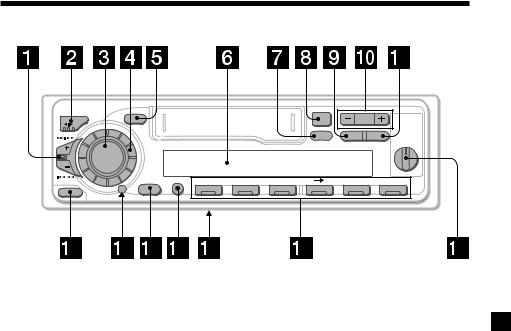
Localización de los controles
|
|
|
|
|
|
– |
+ |
MODE |
SOUND |
|
|
|
6 |
PRST |
|
|
|
|
|
|
|
|
D-BASS |
SEEK / AMS |
|
|
|
|
DSPL |
PTY |
AF/TA |
|
|
|
|
|
|||
|
|
|
|
|
|
|
OFF 1 2 |
|
SOURCE |
|
|
|
|
|
3 |
|
|
|
|
|
|
|
|
|
SHIFT |
|
SET UP |
PLAY MODE |
|
|
|
RELEASE |
OFF |
1 |
2 |
3 |
4 |
5 |
6 |
|
|
|
|
|
|
|
|
XR-5890R/5880R
Consulte las páginas enumeradas para obtener más información.
1Control SEEK/AMS (búsqueda/Sensor de música automático/búsqueda manual) 6, 8, 11, 14
2Botón MODE (*)
Durante la reproducción de cintas: Cambio del sentido de reproducción 6
Durante la recepción de radio: Selección de banda (BAND) 7, 8
3Botón SOURCE (TAPE/TUNER) 6, 7, 8, 12
4Dial (control de volumen/graves/ agudos/izquierdo-derecho/trasero- delantero) 5, 17
5 Botón SOUND 17
6 Visor
7Botón DSPL (cambio del modo de indicación) 6, 9, 10
8 Botón 6 (expulsión) 6
9Botón PTY*
Programa RDS 14
0Botón PRST
Durante la recepción de radio:
Selección de emisoras memorizadas 8
!¡ Botón AF/TA* 10, 11, 12, 13
!™ Botón de liberación del panel frontal
RELEASE 4, 20
!£ Botón de restauración (situado en el lado frontal de la unidad, oculto por el panel frontal) 4
!¢ Botón OFF 4, 6
!∞ Botón SHIFT
PLAY MODE 7, 8, 11, 13 SET UP 5, 14, 17
!§ Selector POWER SELECT
(situado en la parte inferior de la unidad)
Consulte “Selector POWER SELECT” en el manual de instalación y conexiones.
!¶ Botones numéricos 8, 11, 13
!• Control D-BASS 18
* XR-5890R/5880R solamente
3

Procedimientos iniciales
Restauración de la unidad
Antes de utilizar la unidad por primera vez o después de sustituir la batería del automóvil, es necesario restaurar dicha unidad.
Extraiga el panel frontal y pulse el botón de restauración con un objeto puntiagudo, como un bolígrafo.
Botón de restauración
Nota
Al pulsar el botón de restauración se borrarán el ajuste del reloj y algunas funciones memorizadas.
Extracción del panel frontal
Es posible extraer el panel frontal de esta unidad con el fin de evitar su robo.
1 Pulse (OFF).
2Pulse (RELEASE), deslice el panel frontal ligeramente hacia la izquierda y tire de él hacia fuera.
(OFF)
(RELEASE)

Notas
•Tenga cuidado para que el panel no se caiga cuando lo extraiga de la unidad.
•Si extrae el panel mientras la unidad está encendida, la alimentación se desactivará automáticamente para evitar que los altavoces se dañen.
•Cuando lleve consigo el panel frontal, guárdelo en el estuche suministrado para el mismo.
Inserción del panel frontal
Fije la parte a del panel con la parte b de la unidad como muestra la ilustración y presione sobre el lado izquierdo del panel hasta que oiga un chasquido.
a
b
Notas
•Asegúrese de no fijar el panel frontal al revés.
•No ejerza excesiva presión sobre el panel frontal al fijarlo a la unidad.
•No ejerza demasiada presión sobre el visor del panel frontal.
•No exponga el panel frontal a la luz solar directa ni a fuentes térmicas, como conductos de aire caliente, ni lo deje en un lugar húmedo. No lo deje nunca sobre el salpicadero de un automóvil aparcado bajo la luz solar directa ni en ningún otro lugar donde pueda producirse un aumento considerable de la temperatura.
Alarma de precaución
Si gira el interruptor de la llave de encendido a la posición OFF sin haber extraído el panel frontal, la alarma de precaución emitirá pitidos durante unos segundos (sólo si el selector POWER SELECT de la parte inferior de la unidad está ajustado en la posición A).
4
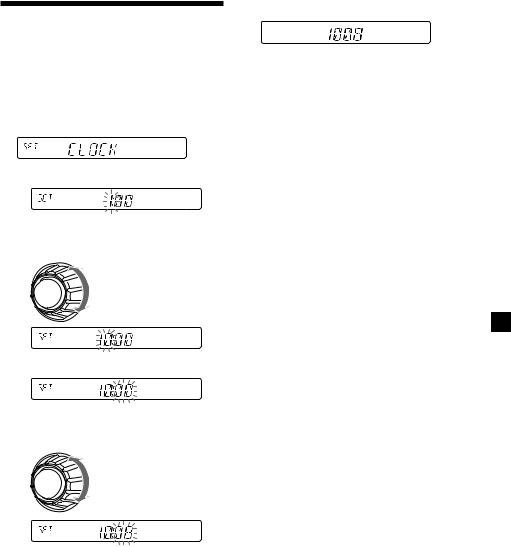
Ajuste del reloj
El reloj dispone de una indicación digital de 24 horas.
Ejemplo: Para ajustar el reloj a las 10:08
1Pulse (SHIFT) y, a continuación, (2) (SET
UP) varias veces hasta que aparezca “CLOCK”.
1 Pulse (4) (n).
La indicación de hora parpadea.
2 Ajuste la hora.
para retroceder
para avanzar
3 Pulse (4) (n).
La indicación de minutos parpadea.
4 Ajuste los minutos.
para retroceder
para avanzar
2 Pulse (SHIFT).
El reloj se pone en funcionamiento.
3Pulse (SHIFT).
Una vez realizado el ajuste del reloj, el visor volverá a mostrar el modo de reproducción normal.
Nota
Si el selector POWER SELECT de la parte inferior de la unidad se ajusta en la posición B, active primero la alimentación y, a continuación, ajuste el reloj.
5
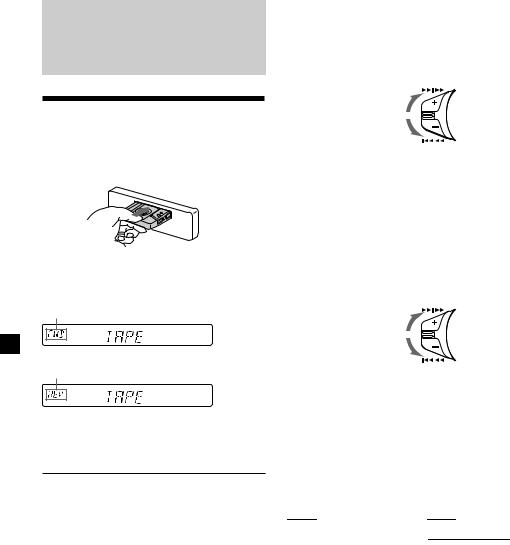
Reproductor de cassettes
Escucha de cintas
Inserte un cassette.
La reproducción se iniciará de forma automática.
Si ya hay un cassette insertado, pulse (SOURCE) varias veces hasta que aparezca “FWD” o “REV” para iniciar la reproducción.
Se reproduce la cara orientada hacia arriba.
Se reproduce la cara orientada hacia abajo.
Consejo
Para cambiar el sentido de reproducción de la cinta, pulse (MODE) (*).
Para |
Pulse |
Detener la reproducción |
(OFF) |
|
|
Expulsar el cassette |
6 |
|
|
Bobinado rápido de la cinta
Durante la reproducción, desplace el control SEEK/AMS hacia arriba o abajo y manténgalo en esa posición.
SEEK / AMS
Avance rápido
Rebobinado
Para iniciar la reproducción durante el avance rápido o el rebobinado, pulse (MODE) (*).
Localización de un tema específico
—Sensor de música automático (AMS)
Durante la reproducción, desplace el control SEEK/AMS hacia arriba o hacia abajo y suéltelo cada vez que llegue al tema que desea omitir.
Es posible omitir un máximo de nueve temas de una vez.
SEEK / AMS
Para localizar temas posteriores
Para localizar temas anteriores
Nota
La función AMS puede no activarse si:
—los espacios en blanco entre los temas son inferiores a cuatro segundos
—hay ruido entre los temas
—existen largas secciones con volumen bajo o sin sonido.
Cambio de los elementos mostrados
Cada vez que pulse (DSPL), el elemento cambiará de la forma siguiente:
|
z Reproducción de cintas |
|
z Reloj |
|
|
|
|
|
|||
|
|
Frecuencia* Z |
|
|
|
|
|
|
|
||
*Siempre que esté activada una de las siguientes funciones.
—Función ATA
—Función AF/TA (XR-5890R/5880R)
Después de seleccionar el elemento deseado, el visor cambiará automáticamente al modo de desplazamiento de indicaciones después de unos segundos.
En dicho modo, todos los elementos anteriores se desplazan por el visor uno por uno en orden.
Consejo
Es posible desactivar el modo de desplazamiento de indicaciones (consulte “Cambio de los ajustes de sonido y visualización” en la página 17).
6
